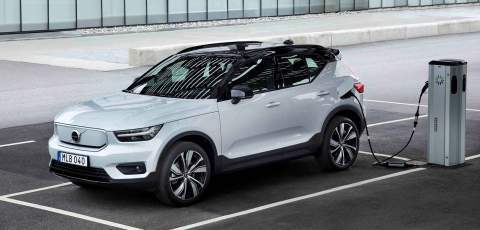
Tags: #ev-emissions
Volvo, and its 'strategic affiliate' Polestar has confirmed that between them, they will reduce their CO2 emissions beyond the target set by the EU Commission. This has been achieved thanks to both brands rapidly electrifying their cars so that the entirety of the ranges having a plug-in option.
Obviously, Polestar was only established as a separate brand comparatively recently, but this makes Volvo's achievement of being the first established car maker to offer a plug-in version of every model in its line-up all-the-more impressive. That said its XC40 Recharge remains the only pure EV in its range, with the Polestar 2 the equivalent from the affiliate brand.
The plug-in gamble has paid off, with Volvo PHEVs comprising over 25 per cent of European sales to this point in 2020. By 2025, the brand is aiming for 50 per cent of its sales to be fully electric cars, with the rest hybrids – making it one of the most progressive manufacturers out there.
In fact, such is Volvo and Polestar's joint success in getting ahead of its emissions targets that it has been able to sell surplus CO2 emissions credits to previous owner, Ford – which is somewhat lagging on electrification. The money that this trade brings in will be reinvested in green technology projects.
You can find out more about the ins and outs of the EU emissions targets themselves – and the carbon credit trade – here.
Volvo has already merged its combustion engine operations with its Chinese owner, Geely, to enable it to concentrate on electrification. It is now investing in the design and development of electric motors in-house to support its electric ambitions.
At the beginning of November, it opened a new electric motor lab in Shanghai, China, which complements a wide network of facilities which are supporting the electrification strategy. These include facilities in Volvo's home country of Sweden where there is an e-motor and battery development programme.
“Through in-house design and development, we can fine tune our e-motors to ever better levels,” said Henrik Green, Chief Technology Officer at Volvo Cars. “By constantly improving their overall performance levels in terms of energy efficiency and comfort, we create an electric driving experience that is unique to Volvo.”
The new motor facility's first project will be on developing the units which will be used in both fully electric and hybrid cars using Volvo's forthcoming SPA2 modular electric vehicle architecture.
All of the above is feeding into the brands' longer-term vision for 2040 when the company aims to be climate-neutral, which extends not just to its own operations, but those of its suppliers. In the shorter term, the goal is to reduce each car's lifecycle carbon footprint by 40 per cent by 2025, including reducing measured tailpipe emissions by 50 per cent from 2018 levels.
The reason for the recent glut of PHEVs hitting the market is simple: manufacturers are scrabbling to meet emissions targets and PHEVs are much easier to develop for manufacturers, and less daunting to buy for a public still adjusting to EVs. Volvo and Polestar have made the most of the PHEV opportunity ahead of the game, giving them the breathing space to develop EVs rather than rushing to curb emissions. The ambitious long-term emissions goals reflect this forward-thinking approach.
Related Articles...